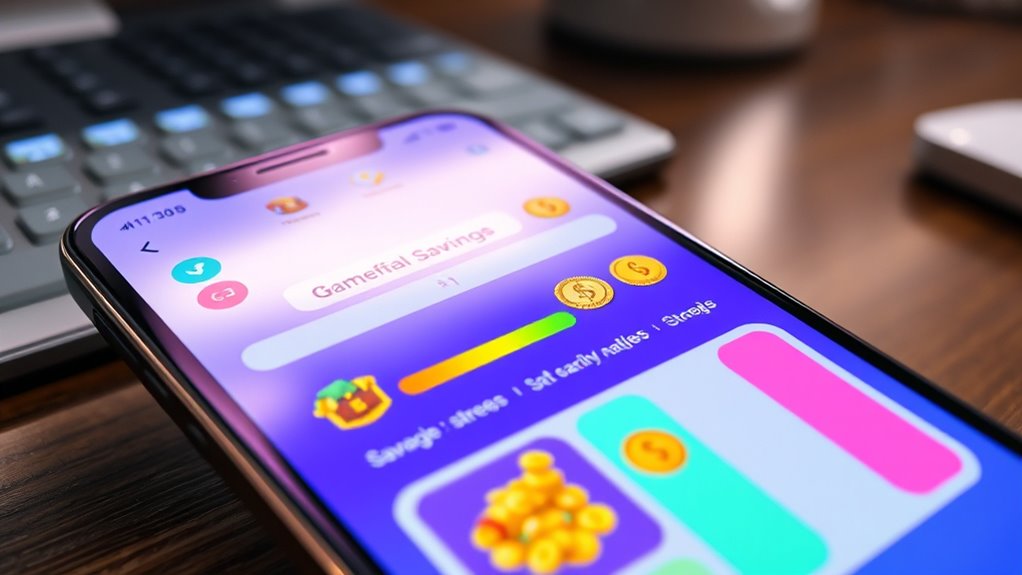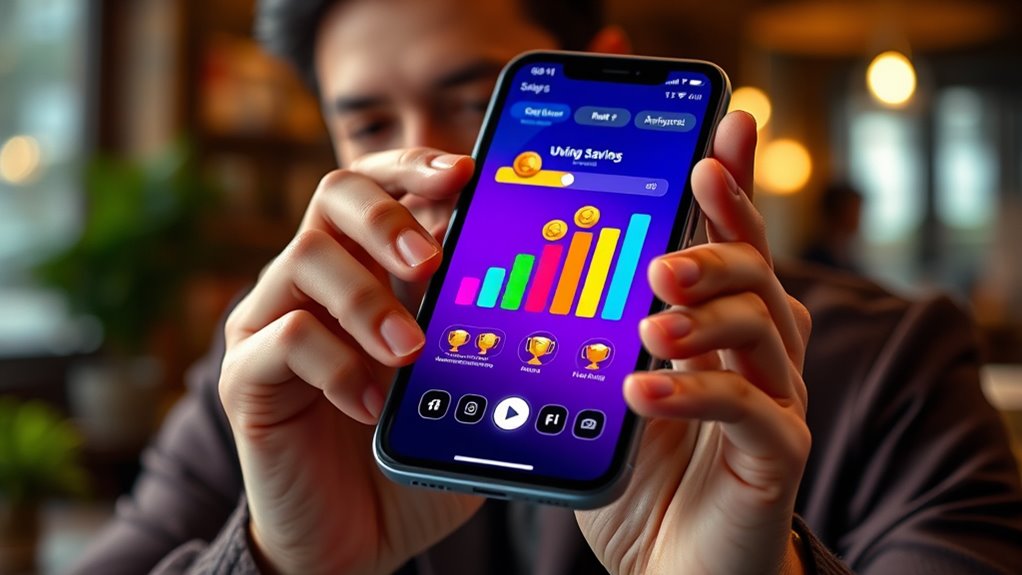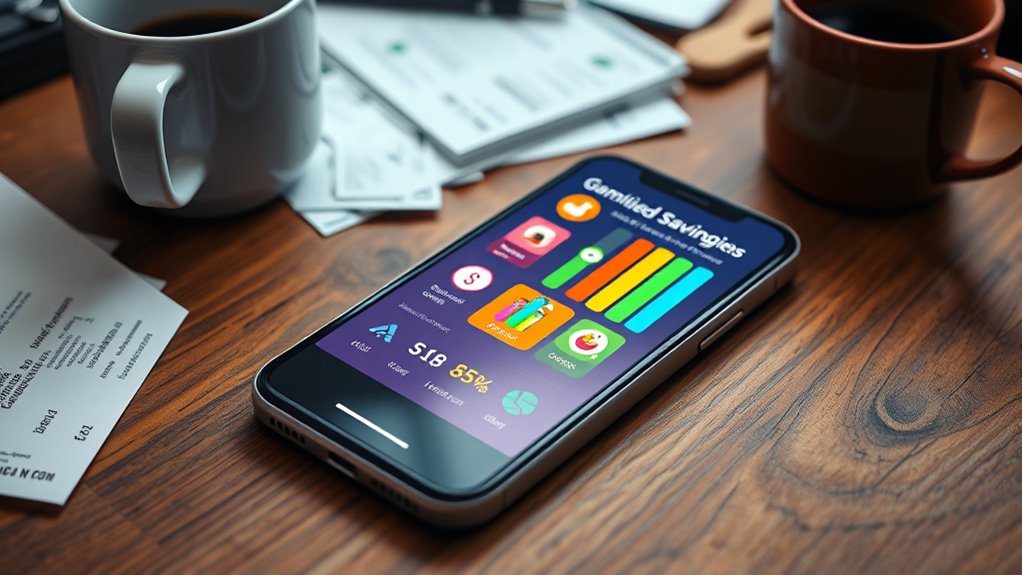Gamified savings apps can be effective at boosting your motivation and helping you save more by making it fun and engaging. They use rewards, badges, progress tracking, and social features that tap into your desire for achievement and recognition. While many users see increased savings and healthier habits, long-term success depends on maintaining discipline beyond the app. Keep exploring, and you’ll discover how these tools can fit into your saving journey.
Key Takeaways
- Gamified savings apps boost user engagement and motivation, leading to increased savings and healthier financial habits.
- Rewards, badges, and social features reinforce positive behaviors and sustain long-term savings efforts.
- Evidence shows users tend to save more and develop consistent habits through gamification techniques.
- Limitations include potential decline in motivation once external rewards diminish or initial excitement fades.
- Combining gamification with disciplined financial practices enhances the likelihood of achieving long-term savings goals.
The Rise of Gamification in Personal Finance

Gamification has revolutionized personal finance by making saving money more engaging and motivating. You no longer have to see saving as a dull chore; instead, game elements turn it into a fun challenge. Financial apps began integrating features like points, badges, and progress tracking to encourage consistent saving habits. This approach taps into your natural desire for achievement and recognition, making it easier to stay committed. As technology advanced, developers realized that gamification could help people overcome common barriers like procrastination or lack of motivation. The rise of these tools reflects a shift toward smarter, more interactive ways to manage money. Now, saving isn’t just a task—it’s an experience that keeps you interested and motivated to reach your financial goals. Additionally, incorporating gamified savings apps can make the process even more effective by providing instant feedback and rewards. The integration of interactive features inspired by gaming ensures users remain engaged over time, enhancing their financial discipline. Furthermore, the use of behavioral psychology principles in designing these apps helps reinforce positive habits and long-term commitment to saving, including techniques that align with the concept of mindfulness and intention to foster better financial decision-making.
How Do Savings Apps Incorporate Game Elements?

Savings apps incorporate game elements by integrating features like points, badges, and levels that reward your progress and keep you engaged. When you save money, you earn points that can *unblock* badges or advance you to new levels, making saving feel like a challenge or achievement. These visual cues and rewards give you immediate feedback, encouraging continued effort. Some apps use progress bars or streaks to show how close you are to a goal, motivating you to stay consistent. Leaderboards or social sharing features add a competitive element, pushing you to save more. Overall, these game-like features turn saving into an interactive experience, making it more enjoyable and helping you stay motivated to reach your financial goals. Incorporating motivational strategies such as rewards and social comparison can further enhance user engagement and success by tapping into behavioral psychology principles. Additionally, leveraging behavioral psychology principles can maximize the effectiveness of these features in promoting consistent saving habits. Recent advancements in AI-driven personalization allow these apps to tailor challenges and rewards to individual user behavior, further boosting motivation and adherence.
Behavioral Psychology Behind Gamified Saving Strategies

The success of gamified saving strategies hinges on how they tap into fundamental principles of behavioral psychology. These apps leverage motivation, reward systems, and habit formation to influence your saving behavior. By understanding your psychological triggers, they make saving feel more engaging and less like a chore. For example, rewards activate your brain’s pleasure centers, encouraging repeated behavior. Habit formation reinforces saving routines over time, making them automatic. Incorporating positive reinforcement techniques can further enhance these effects, encouraging consistent saving habits. Additionally, understanding behavioral biases can help you design more effective savings strategies that counteract tendencies like procrastination or overconfidence. Here’s a quick overview:
| Principle | How it works | Your benefit |
|---|---|---|
| Reward Systems | Incentives for saving milestones | Boosts motivation |
| Immediate Feedback | Real-time progress updates | Reinforces positive habits |
| Social Proof | Showing others’ achievements | Encourages competition and effort |
Additionally, incorporating mindful decluttering techniques into your financial habits can help you better recognize unnecessary expenses and focus on meaningful savings. Practicing this awareness can lead to more intentional and sustainable financial decisions, fostering a deeper understanding of your spending habits.
Evidence of Effectiveness: Do Users Save More?

Research shows that users of gamified savings apps often increase their savings rates and adopt healthier financial habits. These behavioral changes tend to persist over time, indicating long-term habit formation. Additionally, incorporating behavioral change techniques can further enhance the effectiveness of such apps in promoting sustained savings. For example, fostering self-awareness about spending patterns can make users more mindful of their financial decisions. Developing motivational strategies can also reinforce positive behaviors and sustain engagement. Regularly tracking progress and visualizing milestones can help maintain motivation and a sense of achievement. Moreover, integrating cookie-based tracking allows for personalized experiences that encourage continued use. So, the question is, do these apps truly help you save more in the long run?
Increased Savings Rates
Many users find that gamified savings apps actually boost their savings rates by making the process more engaging and motivating. These apps often turn saving into a game, offering rewards, badges, and challenges that encourage consistent deposits. As a result, you’re more likely to save regularly without feeling the effort. Studies show that users of these apps tend to increase their savings amounts compared to traditional methods. The interactive features help you stay focused and committed, turning saving from a chore into an enjoyable activity. By providing immediate feedback and incentives, gamified apps reinforce positive habits and make saving feel rewarding. This increased engagement often translates directly into higher savings rates, helping you reach your financial goals faster. Additionally, understanding key financial terms can further enhance your ability to set appropriate savings targets and track your progress effectively. Incorporating secure payment systems can also facilitate seamless and protected transactions, making it easier to maintain your savings habits.
Behavioral Changes Evident
Since gamified savings apps actively engage you through rewards and challenges, they often lead to noticeable behavioral changes that boost your savings. You might find yourself more motivated to set aside money regularly, as earning points or accessing achievements creates a sense of accomplishment. These apps can shift your mindset from viewing saving as a chore to seeing it as a game, encouraging consistent effort. You may also develop better financial habits, such as reviewing your goals more often or automating deposits. Over time, these small behavioral tweaks can become ingrained, making saving feel more natural and less burdensome. The immediate feedback and positive reinforcement help you stay committed, ultimately fostering a mindset geared toward increased savings.
Long-term Habit Formation
Because gamified savings apps make saving feel engaging and rewarding, you’re more likely to develop lasting habits over time. The game-like elements, such as earning points or revealing rewards, motivate you to save consistently, turning the behavior into a routine. Over weeks and months, these positive reinforcements help solidify saving as a regular part of your financial life. Studies show that users who engage with gamified apps tend to save more in the long run than those using traditional methods. The continuous challenge and feedback loops keep you focused, making saving less of a chore and more of an enjoyable activity. As a result, you’re more likely to maintain these habits well beyond initial enthusiasm, leading to improved financial stability over time.
Potential Drawbacks and Limitations

While gamified savings apps can boost your motivation, there’s a risk of overjustification, where external rewards might reduce your intrinsic desire to save. You may find your interest waning once the initial excitement fades or if rewards become less appealing. This short-term motivation decline can make it harder to maintain consistent savings over the long run.
Overjustification Effect Risks
Although gamified savings apps can boost motivation initially, they also pose the risk of overjustification, where external rewards diminish your intrinsic desire to save. When you rely heavily on badges, points, or monetary incentives, your natural motivation to save for personal goals may weaken over time. This phenomenon can lead you to focus more on earning rewards than on the genuine satisfaction of financial security. If external incentives become the primary reason for saving, you might lose sight of the intrinsic benefits, such as peace of mind and future stability. Over time, this shift can decrease your long-term commitment and enjoyment of saving, making the behavior less sustainable once the external rewards lose their appeal. Recognizing this risk helps you balance external incentives with internal motivations.
Short-term Motivation Decline
Despite their initial effectiveness, gamified savings apps can lead to a decline in motivation over the short term. When the novelty wears off, you might find it harder to stay engaged, especially if rewards become predictable or less exciting. The thrill of earning points or badges diminishes, and your drive to save may fade as the challenge feels less rewarding. Additionally, if the app’s design focuses too much on game elements rather than real financial goals, your long-term commitment can suffer. You might also experience frustration if progress stalls or if the app’s incentives no longer align with your personal motivations. This short-term dip highlights that, without ongoing novelty or meaningful reinforcement, motivation can quickly decline, making it harder to maintain consistent savings habits.
Comparing Popular Gamified Savings Platforms

When choosing a gamified savings platform, it’s vital to compare their features, user experience, and reward systems to find the one that best fits your financial goals. Different apps cater to various motivations and styles, so understanding their strengths is key.
Here are three things to weigh:
- Engagement Level: Does the platform keep you motivated with challenges, badges, or social features?
- Reward Value: Do the rewards feel meaningful, encouraging consistent savings?
- Ease of Use: Is the interface intuitive, making saving effortless and enjoyable?
Are They a Sustainable Solution for Long-Term Financial Goals?

Are gamified savings apps a viable option for achieving long-term financial goals? They can help you stay motivated and committed by making saving feel like a game. However, their sustainability depends on your discipline and the app’s design. While they can boost your initial engagement, long-term success requires consistent effort beyond the app’s features. Some apps incorporate rewards and challenges that keep you interested, but if you rely solely on gamification, your motivation might fade over time. To truly reach your financial goals, combine these apps with solid budgeting, regular reviews, and disciplined saving habits. Gamified apps can be part of your strategy, but they shouldn’t be the only tool you depend on for lasting financial stability.
Frequently Asked Questions
What Demographic Benefits Most From Gamified Savings Apps?
You might wonder who benefits most from gamified savings apps. Typically, younger adults and millennials find these apps engaging because they combine technology and incentives that resonate with their digital habits. If you’re someone who enjoys challenges or rewards, you’ll likely stay motivated to save more. These apps are especially helpful if you’re trying to develop better financial habits or make saving money more fun and interactive.
How Do Different Game Elements Influence User Motivation?
When it comes to motivation, different game elements really can turn the tide. Rewards and badges boost your sense of achievement, making you more enthusiastic to save. Progress bars give you a clear roadmap, keeping you focused. Challenges and leaderboards tap into your competitive spirit. These tools work together to keep you engaged, proving that a little fun can go a long way in changing habits and reaching your savings goals.
Are There Privacy Concerns Associated With These Apps?
You might wonder if privacy issues come with these apps. Yes, there are concerns because they often collect personal data to personalize your experience. If this data isn’t protected properly, it could be misused or stolen. Always read the privacy policy and be cautious about sharing sensitive information. By staying informed and choosing reputable apps, you can enjoy the benefits while minimizing privacy risks.
Can Gamified Apps Replace Traditional Financial Advising?
You might wonder if gamified apps can replace traditional financial advice. While they make saving money more engaging and help you build habits, they lack personalized insights from trained professionals. These apps can supplement your financial planning but shouldn’t fully replace expert advice, especially for complex situations. Use them as motivational tools, but for tailored strategies, consulting a financial advisor remains your best bet.
What Are the Long-Term Behavioral Impacts of Gamification?
Imagine a game where your savings grow with every smart choice—that’s the power of gamification. Long-term, it can turn saving money into a habit, making you more disciplined and motivated. You may find yourself more engaged and less tempted to spend impulsively, like a hero on a quest. Over time, these behaviors can build financial resilience, transforming your attitude toward money and encouraging consistent, positive financial habits.
Conclusion
Gamified savings apps can turn saving money into a rewarding game, making your financial journey feel like a thrilling adventure. While they boost motivation and engagement, they’re not a magic wand for long-term success. Think of them as helpful guides on your path—useful, but you still need to steer your own ship. With the right balance, these apps can transform your savings habits into a rewarding voyage toward financial stability.









